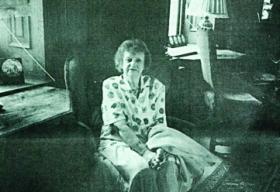From the files of the DIB…‘In the shadow of death’
Published in 20th-century / Contemporary History, Issue 5 (Sep/Oct 2007), News, Volume 15
Countess Mary de Galway O’Kelly in old age.
O’KELLY, Countess Mary de Galway (1905–99), Belgian resistance operative, was born on 24 April 1905 in Dublin, one of ten children of Thomas Patrick Cummins, a plumber, of Waterfall Cottage, Richmond Road, Dublin, and his wife, Ellen Black. Mary attended Fairview National School before moving to the Dominican College in Eccles Street. Showing a remarkable aptitude for languages (especially French) while still young, she decided to travel abroad to develop her skills. She went to Brussels, where she taught English to the twelve children of a Belgian countess and later worked as a translator at the Canadian embassy.
Mary was in Brussels during the German invasion of May 1940, and became involved with the Belgian resistance. Holding an Irish passport, she could travel more freely than locals, which, added to her access to foreign diplomats, made her an invaluable courier; she also worked as a translator and smuggled weapons. After some months she was betrayed to the Gestapo and arrested as she slept in her apartment. Taken to Berlin, she was imprisoned in a concentration camp, regularly subjected to horrific torture and forced to witness the tortures inflicted on others. Moved around continually, she was held in camps in Bremen, Dresden and Essen, among others. Hunger was so intolerable in the camps that she once witnessed inmates resorting to cannibalism. At one time she was among those scheduled for extermination but was saved when the train that was supposed to take her to Auschwitz derailed.
On 25 April 1945 her camp was liberated by American troops, who found her starving, weighing only four stone and suffering from numerous ailments, including decalcification of the spine. She spent several months recovering in hospitals in Switzerland and Paris, and had to wear a ‘plaster jacket’ for six months. In 1946 she received decorations from King Leopold of the Belgians and General Eisenhower.
While in Brussels to undergo an assessment for compensation in 1946 Mary met Count Gui O’Kelly de Galway, a barrister descended from Irish military émigrés. They were married in 1949 and moved to Ireland. In 1964 she accompanied her husband to Dublin airport before he travelled to England on business. After saying goodbye, she never saw him again and, despite strenuous efforts to trace him, never found out what had become of him.
Throughout her life Mary maintained an attitude of stoicism and cheerful optimism. A small, sprightly woman, she was known to her nieces and nephews as ‘Auntie Bunnie’ and was a source of great inspiration to all her extended family. She was a well-known and popular figure in her locality of Clontarf, and in her eighties gave a lengthy interview to RTÉ Radio for a documentary entitled ‘In the shadow of death’. Even in her nineties she went for regular walks on Howth pier, took great care of her appearance, and loved parties. ‘Aren’t I marvellous for my age?’, she would often say. ‘They’ll have to shoot me.’ She died on 20 June 1999 in Dublin, and her ashes are buried in Glasnevin cemetery.
David Murphy is a former editorial assistant with the Royal Irish Academy’s Dictionary of Irish Biography.
'
















